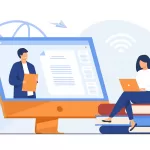In the ever-evolving landscape of technology, artificial intelligence (AI) has made remarkable strides in transforming various aspects of our lives. One of the most intriguing developments in AI is generative AI, particularly exemplified by models like ChatGPT. This blog explores the profound impact that ChatGPT and generative AI are poised to have on the future of work across various industries and sectors. ChatGPT and generative AI represent a significant leap in the future of work, with the potential to automate repetitive tasks, enhance customer service, facilitate decision-making, accelerate content creation, and bridge language gaps.
Understanding Generative AI
Before diving into the ways ChatGPT is shaping the future of work, let’s start by understanding generative AI. Generative AI models, like ChatGPT, are designed to generate human-like text and content. These models use deep learning techniques to analyze and understand text data, enabling them to generate coherent and contextually relevant responses. They have the potential to engage in meaningful conversations, write articles, create code, and perform various other tasks that require natural language understanding and generation.
What are the Popular Use Cases of Generative AI?
Generative AI, including models like ChatGPT, has found widespread applications across various industries due to its remarkable capabilities in understanding and generating human-like text. Here are some popular use cases that highlight the versatility and potential of generative AI:
Content Generation:
Generative AI streamlines content creation by generating articles, blog posts, and product descriptions. It provides a foundation that content creators can build upon, saving time and effort. Marketers and writers use AI-generated drafts as a starting point, ensuring consistent and relevant content for their audience.
Chatbots and Virtual Assistants:
Generative AI powers chatbots and virtual assistants, enhancing customer support and user engagement. These AI-driven conversational agents handle routine inquiries, guide users through processes, and offer assistance in real-time. They improve efficiency by providing instant responses and personalized interactions.
Code Generation and Debugging:
Generative AI aids developers by generating code snippets and assisting in debugging. It expedites the software development process, making coding more accessible to individuals with varying levels of expertise. Developers can rely on AI-generated code as a foundation and refine it to meet specific project requirements.
Translation and Localization:
Generative AI excels in language translation, breaking down communication barriers across different languages. It offers instant and accurate translations, benefiting businesses and individuals in globalized contexts. The technology facilitates international collaboration, marketing, and accessibility of information.
Data Analysis and Reporting:
In data-driven industries, generative AI assists with data analysis and report generation. It can extract insights, create summaries, and visualize complex datasets. This capability empowers decision-makers to derive actionable information from large volumes of data, improving strategic planning and informed decision-making.
ChatGPT: A Glimpse into the Future
ChatGPT, developed by OpenAI, represents a significant leap in generative AI technology. It’s a language model that has been trained on a diverse range of internet text, making it a versatile tool for various applications. ChatGPT has the potential to transform the way we work by providing intelligent, context-aware assistance in a wide range of tasks.

Navigating Challenges in the Adoption of ChatGPT and Generative AI in the Workplace
The implementation of ChatGPT and other generative AI technologies in the workplace holds significant promise, offering businesses the potential for increased efficiency, improved customer service, and streamlined communication. However, like any transformative technology, it also comes with its fair share of risks and challenges. It is crucial for organizations to be aware of these potential pitfalls to harness the benefits of AI while mitigating the associated risks.
Bias and Fairness:
One of the most significant risks associated with ChatGPT and generative AI is bias in the generated content. These AI models learn from vast datasets that may contain biased or prejudiced information. When deployed in a professional setting, they can inadvertently perpetuate bias, leading to discrimination, unequal treatment, or offensive content. Organizations must invest in rigorous bias detection and mitigation strategies to avoid reputational damage and legal consequences.
Security Concerns:
Generative AI systems are vulnerable to manipulation by malicious actors. Hackers can use AI-generated content for phishing attacks, misinformation campaigns, or to create convincing but fake documents and emails. As AI becomes more integrated into workplace communication, organizations must enhance their cybersecurity measures to protect sensitive information and data.
Privacy Issues:
Implementing ChatGPT in the workplace often involves processing large volumes of user data. This raises privacy concerns, as employees may be uncomfortable with their conversations being analyzed or stored by AI systems. Organizations must establish clear data privacy policies, obtain informed consent, and comply with relevant data protection regulations such as GDPR or HIPAA.
Lack of Human Oversight:
Overreliance on AI for critical tasks can lead to a lack of human oversight. While AI can handle routine tasks effectively, it may struggle with complex or nuanced situations. Organizations need to strike a balance between automation and human involvement to ensure that AI is used as a tool to augment human capabilities, not replace them entirely.
Technical Failures:
AI systems are not infallible and can experience technical failures or errors. An AI system like ChatGPT may generate incorrect information or respond inappropriately to user queries, leading to misunderstandings, misinformation, or damage to the organization’s reputation. It’s crucial to have contingency plans in place for such scenarios and ensure that employees are aware of AI limitations.
Depersonalization of Interactions:
Overreliance on AI for communication can lead to a depersonalization of interactions with customers and colleagues. While AI can provide quick and efficient responses, it lacks the emotional intelligence and empathy of humans. This can lead to decreased customer satisfaction and hinder relationship-building efforts.
Regulatory Compliance:
As the use of AI in the workplace continues to grow, governments and regulatory bodies are likely to introduce new regulations and guidelines. Organizations must stay informed about evolving AI-related legislation to avoid compliance issues and potential legal repercussions.
Job Displacement Concerns:
The fear of AI technology replacing human jobs is a legitimate concern among employees. Organizations must be transparent about the role of AI in the workplace and invest in reskilling and upskilling programs to help employees adapt to new roles and responsibilities.
Shaping the Future of Work
As organizations embrace the transformative potential of generative AI like ChatGPT, they are ushering in a new era in the workplace. This technology holds the promise of reshaping how tasks are accomplished, interactions are managed, and decisions are made. In this rapidly evolving landscape, here are some key ways in which generative AI is making a significant impact:
Automating Repetitive Tasks:
One of the most immediate and tangible impacts of generative AI like ChatGPT in the workplace is the automation of repetitive tasks. Mundane and time-consuming activities, such as data entry, content creation, and customer support, can be efficiently handled by AI-powered chatbots and virtual assistants. This frees up human employees to focus on more complex and creative tasks, increasing overall productivity.
Enhancing Customer Service:
ChatGPT and similar AI models are becoming increasingly capable of providing customer support. They can answer frequently asked questions, troubleshoot issues, and offer solutions in real-time. As AI continues to improve its natural language processing capabilities, customer service interactions will become more efficient, reducing response times and improving customer satisfaction.
Facilitating Decision-Making:
Generative AI can assist in decision-making processes by analyzing vast amounts of data and generating actionable insights. In fields like finance and healthcare, where data plays a critical role, AI models can help professionals make more informed decisions, potentially leading to better outcomes.
Accelerating Content Creation:
Content creation, whether in the form of articles, marketing materials, or reports, can be a time-consuming task. ChatGPT can assist content creators by generating drafts, suggesting ideas, and even improving the quality of written content. This not only saves time but also ensures consistency and accuracy in written materials.
Language Translation and Localization:
In a globalized world, language barriers can be a significant hurdle in business. Generative AI models like ChatGPT can instantly translate content into multiple languages, making international communication and market expansion more accessible for businesses of all sizes.
Challenges and Considerations
While the potential benefits of ChatGPT and generative AI in the workplace are significant, they also raise important ethical and practical considerations:
Job Displacement:
The automation of tasks may lead to concerns about job displacement. It’s crucial for organizations to implement AI technologies thoughtfully and consider retraining and upskilling programs to ensure that employees can transition to new roles as automation takes hold.
Ethical Use of AI:
AI models can inadvertently perpetuate biases present in their training data. Organizations must take steps to ensure that AI systems do not discriminate or produce biased content. Ethical guidelines and oversight are essential.
Data Privacy and Security:
AI models require access to vast amounts of data, which raises concerns about data privacy and security. Companies must prioritize data protection and comply with relevant regulations to avoid breaches and mishandling of sensitive information.
Conclusion
ChatGPT and generative AI represent a paradigm shift in how we approach work. They have the potential to automate repetitive tasks, enhance customer service, facilitate decision-making, accelerate content creation, and bridge language gaps. However, these technological advancements also come with challenges related to job displacement, ethics, and data privacy. The future of work will depend on how effectively organizations harness the power of generative AI while addressing these ethical and practical considerations. As we move forward, responsible and strategic adoption of AI will be key to unlocking the full potential of these transformative technologies in the workplace.
Also Read: “Exploring the Divide: Generative AI vs. ChatGPT“.

























